Black Spot on Toenails: Symptoms, Causes & Treatments
Why Are My Toenails That Color?
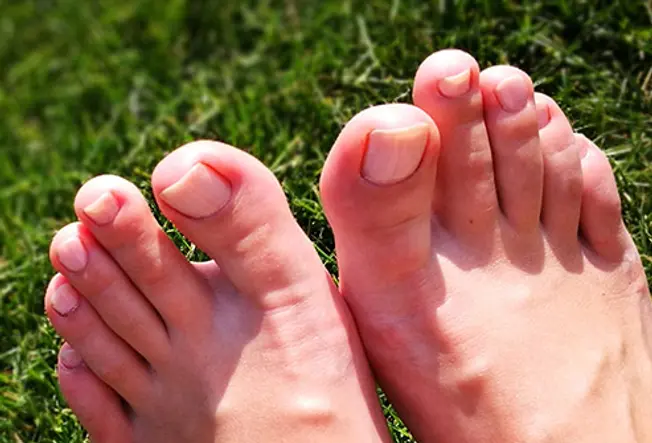
Whether you’re washing your hands or admiring a manicure, you spend a lot more time looking at your fingernails than your toenails. Maybe it’s time to focus on your feet more often (and not just during sandal season). Toenail color changes — from a big blue spot to a thin brown line — could signal health problems. Here’s what you need to know.

Black Toenail: Common Causes
2/11
If your toenail turns black, it’s most likely a bruise under the nail, technically called a subungual hematoma. You can get it from stubbing a toe or from footwear that cram your feet into the front of the shoe. The bruise usually starts out red, then becomes purple, dark brown, and finally black when blood beneath the nail pools and clots. Expect your black toenail to grow out in about 6 to 9 months or longer.
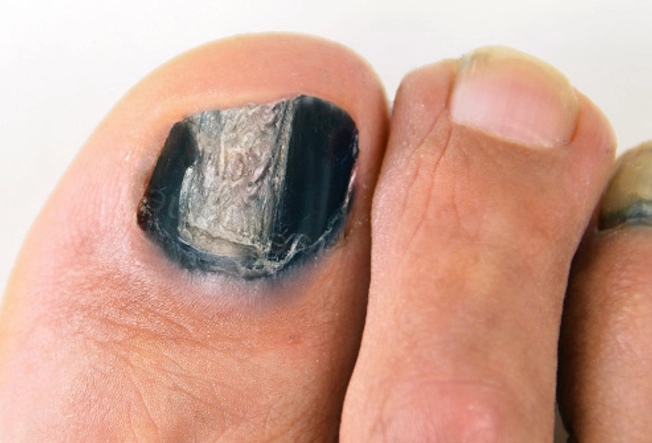
Black toenail: Rare causes
3/11
Say you’re not a runner, your shoes are roomy, and you’re sure you haven’t hurt your toe — yet you have one or more black toenails. Check to see if it’s just that dye has rubbed off from a pair of shoes. If not, head to the doctor. You might have a rare cause of black toenail, such as:
- Malignant melanoma, a serious form of skin cancer
- Fungal infection
- Chronic ingrown nail
- Other health problems
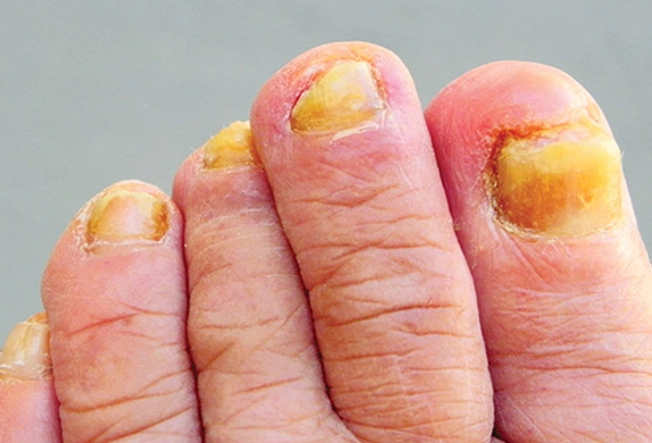
All-yellow Toenails
4/11
When toenails turn yellow, a fungus is usually to blame. This type of fungal infection is so common that you might not even need to see a doctor for treatment. Try an over-the-counter antifungal cream. If your nail is yellow and thick, gently file down the surface so that the drug can reach deeper layers. If at-home treatment doesn’t work, a doctor visit is in order.
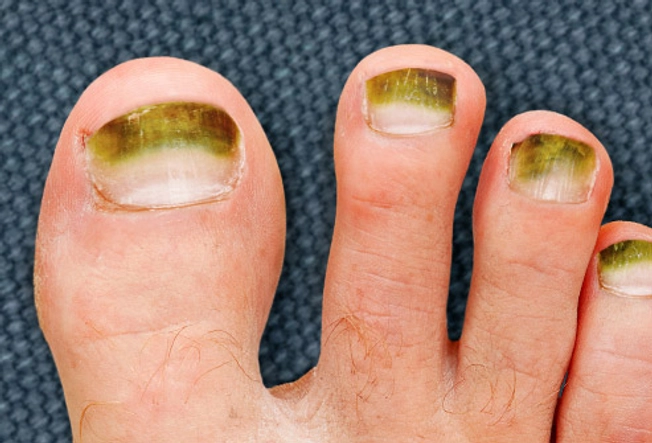
Got Green?
5/11
Unless you’re wearing green nail polish, this is a color you don’t want to see on your toenails. It could be green-nail syndrome (chloronychia), which is caused by an infection. The culprit is usually bacteria that thrive in damp or wet conditions. Think hot tubs, sponges, even tight-fitting shoes that you’ve worn for a long time. The color is underneath the nail, so don’t try to scrub it off. Visit your doctor instead.

Shades of Blue
6/11
If you stub your toe and it turns blue, you might not think twice about the color. But if you get a blue spot or a blue toenail for no clear reason, play it safe and see a doctor. You may have a blue mole beneath the nail. It’s probably harmless. But in very rare cases, a type of blue mole called a cellular blue nevus can become cancer.
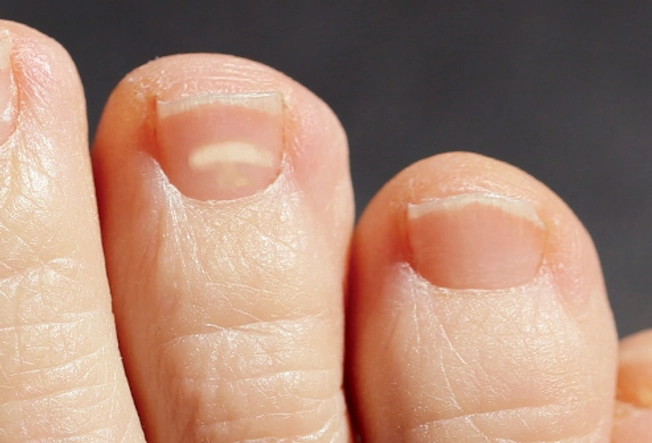
White Spots and Streaks
7/11
Stubbing your toe doesn’t always lead to a bruise. That’s because the blood vessels under the nail might not break and leak blood. Instead, you might get a white spot on your toenail. It won’t don’t disappear like a bruise, but it will grow out in time. Toe trauma can also cause a white streak — though you might not know you hurt yourself. For example, it can happen when sneakers are too small and your toe hits the front of the shoe.

White All Over
8/11
Do you have a toenail that’s turned white, or has large powder-like patches? You could have a fungal infection, most likely one called white superficial onychomycosis. If possible, see a doctor as soon as you notice it. This infection spreads across the toenail. White superficial onychomycosis can cause the entire nail to become rough and crumbly.
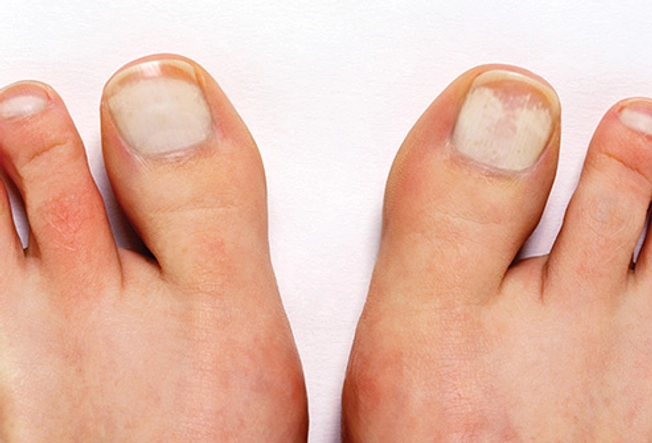
Whitish or Yellowish Patch
9/11
Another type of fungal infection is called proximal subungual onychomycosis. It looks like a whitish or yellowish patch that starts at the base of the toenail, near the cuticle. The infection is rare in healthy people. More often, it happens in people with weakened immune systems. It can also be a sign of HIV.

Candy Cane Stripes
10/11
When toenails have red and white stripes, there are usually problems elsewhere on your body. These lines and V-shaped nicks are a hallmark of Darier disease. It’s an inherited disease, mostly affecting the skin and causing greasy, warty, foul-smelling blemishes.
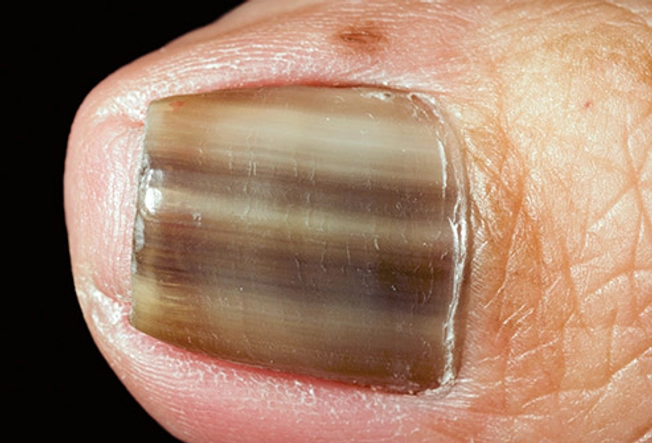
Brown Streaks
11/11
The term for brown and sometimes black color on your toenail is melanonychia. Brown usually appears as a line or streak going up and down the nail. Possible causes:
- Injury
- Melanoma
- Inflammatory conditions
- Fungal infections
- Certain medications
Because there’s a small chance your brown toenail streak could be a sign of something serious, play it safe and get checked out.
Show Sources
IMAGES PROVIDED BY:
1) Daiva Boguckiene / EyeEm / Getty Images
2) amesy / Getty Images
3) Manuel Faba Ortega / Thinkstock
4) SandroSalomon / Thinkstock
5) benstevens / Thinkstock
6) poco_bw / Thinkstock
7) RoniMeshulamAbramovitz / Thinkstock
8) ISM / Medical Images
9) Gary Ombler / Getty Images
10) Bhownit Singh / EyeEm / Getty Images
11) DR P. MARAZZI / Science Source
American Osteopathic College of Dermatology: “Green Nail Syndrome,” “Subungual Hematoma.”
The Australian Journal of Dermatology: “Subungual and periungual congenital blue naevus.”
American College of Foot and Ankle Surgeons: “White Toenails,” “Black Toenails.”
American Family Physician: “Treating Onychomycosis.”
U.S. National Library of Medicine: “Darier disease.”
Mayo Clinic: “Nail fungus.”
Black Spot on Toenails: Symptoms, Causes & Treatments
It doesn’t come as a surprise that we feel concerned about certain dark spots that mysteriously appear around our body at times when we don’t expect it. If you have a black spot under toenails, this article should be able to cover all of your concerns.
Be Concerned about Black Spot on Toenails
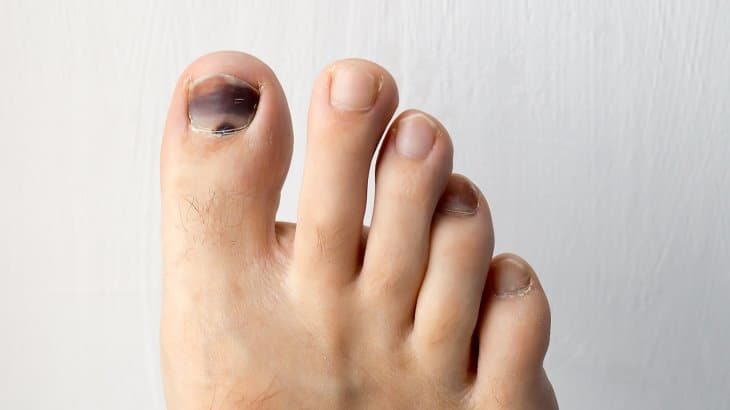
So, you have found dark spots under your toenails – possibly just one, or maybe there’s several of them on your toes. What’s next? It’s normal to worry, but depending on your recent activities and health conditions, you might not need to worry too much.
Just to be clear, we are talking about any dark spot. Even if the spot is not black in color, you still carry the same health risks as you would with black dots beneath your toenails.
Are Those Dark Spots Fungi Growths?
With the high number of nail fungal infections that you can easily get in contact with, it’s no surprise if it does turn out to be a fungal infection, in which case you usually needn’t worry too much unless it has brought along some bacterial infections as well.
However, on the other hand, you should still be cautious and don’t mark it as a fungal infection immediately since there are several reasons why you might have gotten the black toenails.
Causes of Black Dot under Your Toenails
There are several reasons why dark spots can appear on your toenails, and if you want to truly resolve the problem you’ll need to figure out the root of the problem.
- Aside from fungi growths, the spots could have been caused by injuries or trauma to the toenails.
- On a more serious note, it could also be toenail cancer, otherwise known as subungual melanoma.
Signs & Symptoms of Toenail Fungus
Noticeable signs of the black toenail fungus are:
- If the dark spot is indeed caused by fungal infections, you can expect your nails to appear discolored.
- At time same time, your toenails could be hard and brittle nails due to the fungi’s growths and give out a foul smell as well.
- Some patients have also reported their skin feeling sore just around the affected toenails.
- Sometimes, if your toes are already injured and have been left untreated for a while, you also might contact fungal infection. In turn, these fungal infections turn your nails weak so that they get injured more easily. As such, you might be stuck in a vicious cycle of toenail injuries and fungi growths.
- One of the earliest signs of toenail fungi, for one, could be a tiny white or yellow dot on your nail. These dots are most likely to turn dark or turn black afterward.
Treatments for Toenail Fungi
If you have a black toenail infection, you need to get it removed and treated quickly. This is because these fungal infections are easily contactable and very contagious. These fungi tend to strive in wet and dark environments as well, so you’d want to treat it quickly.
Tea tree oil is one of the most effective agents to get rid of nail fungi. You can also use anti-fungal nail polish on your nails, and apply any similar creams and gels.
Home Remedies
Like most other conditions, there are also home remedies which you can use to treat your toenail fungus. Here’s a pro tip for you-
- If your black spot is caused by injuries or blunt trauma, you can get rid of the blood clots simply by soaking the affected toes in a basin of warm water to encourage blood flow.
- Don’t stop using whichever remedy that you have chosen until you are sure that the fungi are completely gone! In fact, to play safe, you can even keep using the treatment option for a while more after the fungi have gone away.
- Some of the home remedies that you can use include apple cider vinegar and coconut oil.
Learn The Curative Methods of Dark Spot Under Your Toenails
How to Prevent Black Spot on Toenail
If your dark spot is caused by accidental trauma and injuries, then there are very few ways which you can prevent them from forming if you have already hit your toes on a hard surface.
- Be more careful about tools and places where you might injure your toes.
- Since these fungi are infectious and can grow where it is damp and moist, one of the best ways that you can prevent getting toenail fungus is by keeping your nails short so that there is very little space for them to grow.
- If you usually do pedicures, it will be a good idea not to share your tools with other people – even your family members, so that if any of you have the infection, it will not spread to someone else.
Is There Any Cancer Risk With These Spots?
Usually, fungal growths will cause a circular black spot to form on your toenails. If you notice your toenail is turning black and which don’t go away even after your toenails grow out, or if they continue spreading, you should consider seeing a doctor.
Sometimes, melanomas can appear very similar to dark spots formed due to trauma, except that they usually show up as vertical stripes – either dark brown or black in color, similar to bruises.
In any case, if you are concerned about any black spots on toenails or anywhere else on your body, you should immediately seek professional medical advice from your doctor instead of trying to diagnose it by yourself. This can prevent plenty of unnecessary troubles in the long run for both the doctor and you.
Vanessa is a fun-loving girl who loves to color her nails and experiment with new beauty trends. She trained at Empire Beauty School, and now she’s a freelance beauty writer. Vanessa loves trying out new products and sharing her thoughts with her readers. When she’s not writing or painting her nails, she can be found exploring the city of New York.






